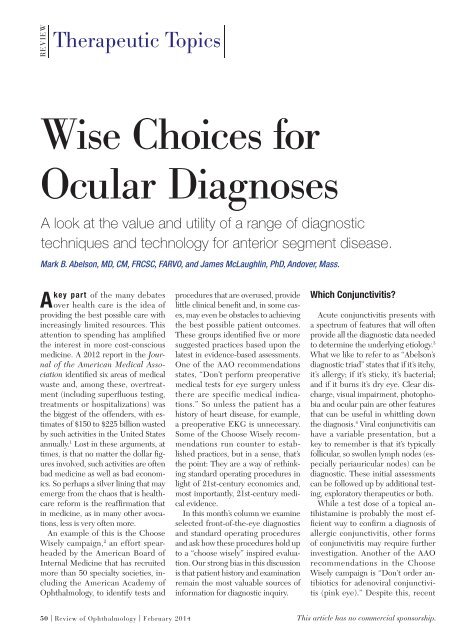dhjBa
dhjBa
dhjBa
Create successful ePaper yourself
Turn your PDF publications into a flip-book with our unique Google optimized e-Paper software.
REVIEW<br />
Therapeutic Topics<br />
Wise Choices for<br />
Ocular Diagnoses<br />
A look at the value and utility of a range of diagnostic<br />
techniques and technology for anterior segment disease.<br />
Mark B. Abelson, MD, CM, FRCSC, FARVO, and James McLaughlin, PhD, Andover, Mass.<br />
key part of the many debates<br />
A over health care is the idea of<br />
providing the best possible care with<br />
increasingly limited resources. This<br />
attention to spending has amplified<br />
the interest in more cost-conscious<br />
medicine. A 2012 report in the Journal<br />
of the American Medical Association<br />
identified six areas of medical<br />
waste and, among these, overtreatment<br />
(including superfluous testing,<br />
treatments or hospitalizations) was<br />
the biggest of the offenders, with estimates<br />
of $150 to $225 billion wasted<br />
by such activities in the United States<br />
annually. 1 Lost in these arguments, at<br />
times, is that no matter the dollar figures<br />
involved, such activities are often<br />
bad medicine as well as bad economics.<br />
So perhaps a silver lining that may<br />
emerge from the chaos that is healthcare<br />
reform is the reaffirmation that<br />
in medicine, as in many other avocations,<br />
less is very often more.<br />
An example of this is the Choose<br />
Wisely campaign, 2 an effort spearheaded<br />
by the American Board of<br />
Internal Medicine that has recruited<br />
more than 50 specialty societies, including<br />
the American Academy of<br />
Ophthalmology, to identify tests and<br />
procedures that are overused, provide<br />
little clinical benefit and, in some cases,<br />
may even be obstacles to achieving<br />
the best possible patient outcomes.<br />
These groups identified five or more<br />
suggested practices based upon the<br />
latest in evidence-based assessments.<br />
One of the AAO recommendations<br />
states, “Don’t perform preoperative<br />
medical tests for eye surgery unless<br />
there are specific medical indications.”<br />
So unless the patient has a<br />
history of heart disease, for example,<br />
a preoperative EKG is unnecessary.<br />
Some of the Choose Wisely recommendations<br />
run counter to established<br />
practices, but in a sense, that’s<br />
the point: They are a way of rethinking<br />
standard operating procedures in<br />
light of 21st-century economics and,<br />
most importantly, 21st-century medical<br />
evidence.<br />
In this month’s column we examine<br />
selected front-of-the-eye diagnostics<br />
and standard operating procedures<br />
and ask how these procedures hold up<br />
to a “choose wisely” inspired evaluation.<br />
Our strong bias in this discussion<br />
is that patient history and examination<br />
remain the most valuable sources of<br />
information for diagnostic inquiry.<br />
Which Conjunctivitis?<br />
Acute conjunctivitis presents with<br />
a spectrum of features that will often<br />
provide all the diagnostic data needed<br />
to determine the underlying etiology. 3<br />
What we like to refer to as “Abelson’s<br />
diagnostic triad” states that if it’s itchy,<br />
it’s allergy; if it’s sticky, it’s bacterial;<br />
and if it burns it’s dry eye. Clear discharge,<br />
visual impairment, photophobia<br />
and ocular pain are other features<br />
that can be useful in whittling down<br />
the diagnosis. 4 Viral conjunctivitis can<br />
have a variable presentation, but a<br />
key to remember is that it’s typically<br />
follicular, so swollen lymph nodes (especially<br />
periauricular nodes) can be<br />
diagnostic. These initial assessments<br />
can be followed up by additional testing,<br />
exploratory therapeutics or both.<br />
While a test dose of a topical antihistamine<br />
is probably the most efficient<br />
way to confirm a diagnosis of<br />
allergic conjunctivitis, other forms<br />
of conjunctivitis may require further<br />
investigation. Another of the AAO<br />
recommendations in the Choose<br />
Wisely campaign is “Don’t order antibiotics<br />
for adenoviral conjunctivitis<br />
(pink eye).” Despite this, recent<br />
50 | Review of Ophthalmology | February 2014 This article has no commercial sponsorship.


